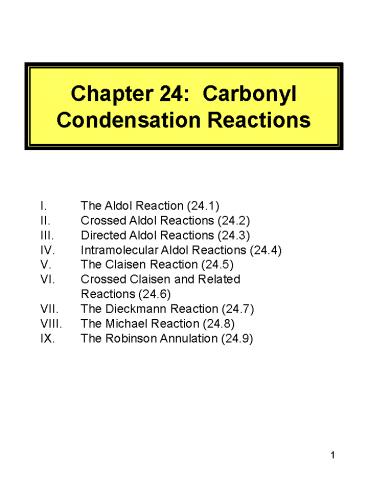Chapter 24: Carbonyl Condensation Reactions - PowerPoint PPT Presentation
1 / 21
Title:
Chapter 24: Carbonyl Condensation Reactions
Description:
B. Dehydration of the Aldol Product. Aldol addition product readily loses H2O: 2-butenal. Dehydration is unavoidable when the product is highly conjugated. 5 ... – PowerPoint PPT presentation
Number of Views:251
Avg rating:3.0/5.0
Title: Chapter 24: Carbonyl Condensation Reactions
1
Chapter 24 Carbonyl Condensation Reactions
- The Aldol Reaction (24.1)
- Crossed Aldol Reactions (24.2)
- Directed Aldol Reactions (24.3)
- Intramolecular Aldol Reactions (24.4)
- The Claisen Reaction (24.5)
- Crossed Claisen and Related Reactions (24.6)
- The Dieckmann Reaction (24.7)
- The Michael Reaction (24.8)
- The Robinson Annulation (24.9)
2
I. The Aldol Reaction A. General Features
Mechanism
Aldol Addition
b-hydroxybutyraldehyde3-hydroxybutanal
3
Aldol Reaction of Propanal
Aldol Addition
a-methyl-b-hydroxyvaleraldehyde2-methyl-3-hydroxy
pentanal
- Aldol reactions are reversible.
- Products are favored with aldehydes.
- Reactants are favored with ketones.
4
B. Dehydration of the Aldol Product Aldol
addition product readily loses H2O
2-butenal
Dehydration is unavoidable when the product
is highly conjugated.
5
Mechanism
E1cB mechanism deprotonation of a C
precedes loss of leaving group from b C.
- Retrosynthetic Analysis1. Locate the a and b
carbons.2. Disconnect to identify the aldehyde
or ketone reactants.
6
II. Crossed Aldol Reactions A. With Two
Different Aldehydes That Have a H
Atoms
- Four products are formed.
- Reaction is not synthetically useful.
7
B. Synthetically Useful Crossed Aldol
Reactions 1. Only one Carbonyl Reactant
has a H
- Yield of crossed aldol product maximized when
benzaldehyde is used in excess.
2. Reactions of Active Methylene Compounds
- Active methylene compounds are always the enolate
component of crossed aldol reactions.
8
Reaction of benzaldehyde with an active
methylene compound
III. Directed Aldol Reactions
- Variation of crossed aldol reaction
- Prepare enolate of first carbonyl compound
with LDA. - Add second carbonyl compound (electrophile).
9
Retrosynthetic Analysis1. Locate the a and b
carbons.2. Disconnect to identify reactants.
IV. Intramolecular Aldol Reactions
- Enolate anion (nucleophile) and carbonyl
(electrophile) are in the same molecule. - Five and six-membered rings are favored.
10
Mechanism
Intramolecular aldol reaction that forms a
six-membered ring
11
V. The Claisen Reaction
Mechanism
12
Retrosynthetic Analysis1. Locate a carbon
(between the carbonyls).2. Disconnect to
identify reactants.
ethyl hexanoateethyl caproate
VI. Crossed Claisen Related Reactions A.
Between Two Esters Only One Has a Hs
no a Hs
Also works with HCO2Et.
13
B. Between an Ester and a Ketone
ethyl
b-dicarbonylformate
compound
- Works best with esters that lack aHs.
C. Between an Ester and Diethyl Carbonate
or Ethyl Chloroformate
14
Mechanism
- Enolate formation
- Nucleophilic attack on CO
- Elimination of leaving group
b-keto ester
VII. Dieckmann Reaction
- Intramolecular Claisen reaction
- Forms five- and six-membered rings.
15
Mechanism
- Formation of ester enolate anion
- Nucleophilic attack
- Leaving group departure
- Formation of b-keto ester enolate
- Add acid to get b-keto ester.
16
VIII. Michael Reaction
resonance-stabilized a,b-unsaturated carbonyl
compound
Resonance hybrid both carbonyl carbon and b
carbon are electrophilic.
Michael Reaction
17
- a,b-unsaturated carbonyl compound is
electrophile (Michael acceptor). - Nucleophile (Michael donor) is an enolate.
- Active methylene compounds are common.
- Hydrolysis and decarboxylation of Michael
products give 1,5-dicarbonyl compound.
Mechanism
18
IX. Robinson Annulation
- Tandem Michael addition and intramolecular aldol
condensation - Forms C-C bonds and six-membered ring.
Examples
19
Mechanism, Part 1 Michael Addition
new C-C bond
20
Mechanism, Part 2 Intramolecular Aldol
Reaction
21
Retrosynthetic Analysis1. Locate ring that
contains a,b-unsaturated carbonyl.2.
Disconnect CC and Cb-C to identify
reactants.
Synthetic direction































